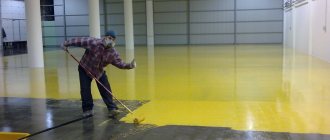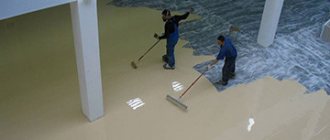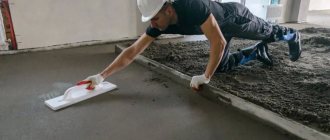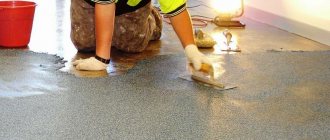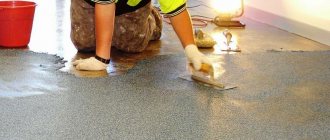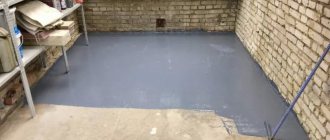Concrete floors have many advantages and only one drawback - insufficient surface strength, which wears out during use. Concrete floor topping strengthens the top layer of concrete, increases its strength and extends its service life. When laying the mortar, the dry reinforcing mixture is applied to a wet concrete slab, grouted with a grouting machine and covered with a layer of membrane former. The main feature of this type of flooring is that it does not require additional protection on top of the hardener.
What is a heavy-duty concrete foundation?
Conditions, timing of concreting and operation of the base affect the methods of concrete hardening:
- Topping. The application of dry mixtures and their further grouting is carried out on freshly laid screeds.
- A liquid type of impregnation (lithium hardener) is used for finished, recently laid or old floors.
Topping (hardener) consists of a special mixture of fixing agents for application to the top layer of concrete mortar for the purpose of strengthening; its thickness is generally several millimeters. Topped concrete floors are made from high quality cement, solid and liquid components and pigments. With the application of the mixture, strength increases by 3 times, and wear resistance by 4.
The floor surface with topping brings lower grades to match M600-M800.
A rotary trowel will help to rub the composition into the concrete, after which impregnation is applied.
The composition is rubbed into the concrete using a rotary trowel. A special impregnation (sealer) is applied as the final stage after grouting the dry mixture. Its composition can be both organic and mineral. The fixer hardens due to the water component in the concrete. The pores on the surface of the concrete are closed, making the base dust-free. Characteristics of a concrete floor using topping:
- frost-resistant;
- waterproof;
- high-strength (service life 7-10 years at maximum load);
- dust-free;
- high adhesion;
- shockproof;
- chemically inert;
- sparklessness;
- reduced abrasion (0.2-0.5 g/cm2);
- resistant to petroleum products;
- environmentally friendly and hygienic.
Composition and properties of dry topping
The optimal mixture is obtained by mixing the main components:
- plasticizers to increase plasticity and water resistance;
- cement;
- fixatives with pigments.
The sealer is used as a waterproofing layer to prevent cracking and drying out of the mixture.
The properties of a plasticizer for concrete is to accelerate the development of strength not only at the pouring stage, but also the finished surface. Sealers on flooring with toppings are used as moisture-retaining impregnation. This will prevent the concrete composition from drying out and cracking. No further maintenance is required for concrete after application.
Technology of strengthening concrete with topping
Hardeners can not be applied to any concrete surface. If a grade of concrete lower than M 300 was used when pouring the floor, then the topping will not give a visible result, and the protective layer will quickly crack. There are also several requirements that must be met.
Features of work
It is worth considering the thickness of the screed being poured. If an old concrete base is being processed, its height should not be less than 70 mm. If laying is carried out on a fresh base, the layer thickness should be at least 120 mm.
The level of surface differences cannot exceed 5 cm.
Work is best carried out at a temperature of at least +10 degrees. If the weather is cool, then you need to take care of heating the room. The main thing is that the temperature of the screed does not drop below +5 degrees.
Topping is not the simplest technology for treating concrete surfaces, so work must be performed in strict sequence.
Strengthening concrete
Grouting of concrete using hardeners is carried out 6-8 hours after laying the screed, when the floor has dried to the extent that small deep imprints remain in it. Next, you need to complete the following steps:
- Pour in approximately 65% of the topping (of the total mass prepared for processing) and distribute the composition evenly over the surface.
- The mixture will begin to absorb moisture contained in the concrete. You must wait until the composition darkens - this will be a sign that you can start grouting.
- Start processing using a special trowel.
- When the entire mixture has been completely rubbed into the concrete base, you must wait until the surface sets.
- As soon as there is an imprint about 1 mm deep on the floor, it is necessary to distribute the remaining 35% of the mixture over the surface.
- Wait a few hours.
- Sand the surface. To do this, you need to remove the grouting blades from the grinding machine and install the sanding products.
- Apply fixing impregnation.
- Cover the floor with polyethylene.
- After 2 days, make shrinkage joints, which will need to be sealed with sealant in 2-3 weeks.
If everything is done correctly, you will get a smooth and durable surface.
It remains to say a few words about the price of the issue.
Laying process and characteristics
A concrete hardener rubbed into the surface greatly enhances its strength and improves the characteristics of the base, but without changing its initial properties. But such a floor is unsuitable for use if it is affected by acids and alkalis in the chemical industry. Treatment of the top layer increases wear resistance to 0.22 g/cm² (9th wear resistance class), and the hardness of concrete on the Mohs scale to 6. The strength of concrete at the time of full force is transferred to it is observed after 28 days, when the concrete has completely hardened.
Steps for doing your own topping:
- Preparing the base.
- Pouring concrete mixture.
- Applying topping for concrete.
- Grout.
- Treatment with strengthening dust-removing impregnation or membrane former.
- Cutting and filling seams.
Advantages and disadvantages
Topping floors have a number of positive qualities, which include the previously listed properties: strength, dust resistance, ease of cleaning, water resistance. It is necessary to name the disadvantages of the coating:
- As befits concrete floors, topping ones have joints;
- The finishing layer is not resistant to aggressive chemical environments, unless otherwise indicated in the characteristics of the specific composition;
- The surface cannot be repaired, only complete renovation. However, this drawback is conditional, since the integrity of the layer is really difficult to destroy, and the surface serves faithfully for at least 15 years, provided that the composition is chosen correctly for use in specific conditions.
Varieties
Corundum topping is used for surfaces that are subject to heavy operational load.
Toppings used to strengthen concrete floors are of 3 types:
- Based on quartz. Used for floors with medium mechanical load.
- With the addition of corundum. Recommended for use on substrates subject to heavy operational loads.
- Metallized. This type is suitable for fairly heavily loaded concrete floors.
Toppings with added corundum
This type is used for slightly increased floor loads. These are places where factory workers or small vehicles frequently pass indoors, where abrasion occurs. Corundum hardeners contain, in addition to sand, crushed clinker powder and plasticizing additives, corundum chips. This component prevents their rapid destruction and adds shine. Experts say that corundum hardeners for concrete floors are often 20% more expensive than those with the addition of quartz.
Quartz hardener
It is the low cost that ensures its high popularity. Its main area of application is covering concrete floors in warehouses, shops, parking lots and workshops. Quartz-based topping can withstand average operating loads. For color variations and increased aesthetics, a coloring pigment is used.
Properties of metallized topping
It contains metal shavings and concrete mortar, which ensures the preservation of performance at a given design level and its strength. This type of topping is used on a set of production means necessary to carry out the production process, for example, for the installation of heavy machines and related equipment, the passage of special technical machines weighing several tons. It is not used in households. It provides strengthening of the upper thin layer of concrete, eliminating residual deformations under the influence of loads.
It is worth noting that the increase in compressive strength and wear resistance of concrete occurs exclusively in the top layer, which is 3 mm thick; in the remaining parts of the capillary-porous body of concrete, the properties and characteristics will correspond to the class poured into the pouring strip.
Topping Defects. List of objects with various defects and destruction of topping
TeoKhim LLC presents a list of various types of objects from different regions of Russia on which topping floors were performed. These floors have defects characteristic of topping: peeling, cracking, destruction of the hardened layer as a result of mechanical loads or exposure to chemically aggressive substances.
You can sort by “object type”, “region”, “repair topping”.
| № | Object type | Pl. m2 | Region | Repair of topping with Elakor |
| Parking | 17200 | Moscow region, Elektrostal | No | |
| Parking | 5000 | Moscow, Vernadskogo Ave. 34 | No | |
| Shopping mall | 5000 | Surgut, Khanty-Mansi Autonomous Okrug-Yugra, shopping center "Lenta" | Epoxy impregnation | |
| Stock | 350 | Tyumen, "Tyumen Broiler" | No | |
| Shopping mall | 5500 | Tyumen, shopping center "Leroy Merlin" | No | |
| Shopping mall | 700 | Tyumen, shopping center "Mebel Group" | No | |
| Shopping mall | 5500 | Khabarovsk, shopping center "Leroy Merlin" | No | |
| Parking | 4000 | Novosibirsk, residential building | Polyurethane coating | |
| Shopping mall | 5500 | Tyumen, shopping center "Lenta" | No | |
| Parking | 40000 | Novosibirsk, shopping center "Gallery Novosibirsk" | No | |
| Parking | 2000 | Ekaterinburg, BC "Consul" | No | |
| Shop | 30000 | Saint Petersburg, | Polyurethane coating | |
| Shopping mall | 3000 | Samara, Decathlon shopping center | No | |
| Shop | 11000 | Lipetsk, radiator plant | Epoxy impregnation | |
| Stock | 5800 | Sverdlovsk region, confectionery factory | No | |
| Stock | 3000 | Tyumen, Logisticheskiy. | No |
Leading manufacturers
The dry type of Alfapol Corundum mixture is used for freshly laid concrete screed.
A hardener for treating a concrete floor is selected depending on its type, application and manufacturer. Russian-made toppings are almost always in warehouses; if necessary, the required volumes of products can be delivered or made within a few days, if this concerns the main shades, and for colored shades – up to 2 weeks. For freshly laid concrete screeds, use a dry type of topping (“Alfapol Corundum” or “Mastertop”). To enhance the hydrophobic properties - compositions of complex additives (Kalmatron, Etalon, Interhard). The most famous brands and products on the market:
- “Protexil” LLC “NPO KRASKO” is a deep penetration dust-removing impregnation made on an organic basis.
- "Interhard" LLC "InterAqua" - liquid lithium hardener.
- Alliance LLC SuperTop, Sealer, LiTec - topping, sealer and lithium impregnation.
- "Elakor-PU" Siler is a water-retaining impregnation for concrete.
- "Di-Trade" Durocem - concrete care.
Scope of application of the hardener
View “SNiP 2.03.13-88” or
The installation of concrete floors and coverings is regulated by SNiP 2.03.13-88. Experts do not recommend using the strengthening mixture in areas where there is active use of aggressive chemicals. The scope of application of reinforced concrete industrial floors is as follows:
In most cases, reinforced flooring is used in the construction of parking lots or parking lots.
- Warehouses.
- Precision mechanics and electronics enterprises.
- Industrial premises with high operating loads.
- Parking lots, garage complexes, parking lots.
- Medical institutions.
- Loading and unloading areas.
What are the advantages of topped floors?
If we talk about the positive aspects of using such compositions, then it is worth highlighting the following nuances:
- topping floors do not allow moisture to pass through;
- Hardened surfaces are much easier to maintain;
- the service life of floors is significantly increased;
- the compounds are inexpensive.
If we talk about the disadvantages of using such mixtures, we can only highlight very low resistance to chemicals. Some claim that after treatment with toppings, seams form on the surface. In fact, it all depends on the technology for applying the compounds, their brand and type.
Final word
Concrete industrial floors and hardened surface technologies are designed to improve the quality of the surface of fresh mortar with dry mixtures, which are rubbed in using a self-propelled road machine designed for the installation of cement concrete pavement. Strengthening mixtures provide a monolithic coating of the concrete floor, the absence of defects and delaminations, preventing dust formation, greatly increasing its resistance to impacts (impact and wear resistance) without changing the timing of the work.
Main advantages
The main advantage of the technique is the ability to extend the life of the concrete screed by strengthening the surface layer. Thanks to the use of additional reinforcing materials, other properties of the monolith are also improved:
- resistance to moisture and frost;
- inertness to household chemicals, petroleum products;
- environmentally friendly due to the absence of cement dust.
The topping floor has less water absorption compared to concrete, which simplifies the cleaning process. The coating becomes more presentable due to pigment additives. This allows you to save money on decorative finishing of the base.

